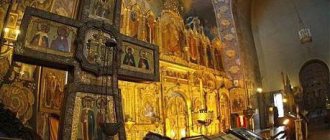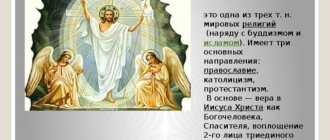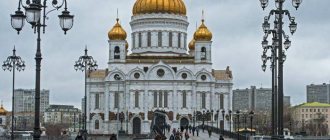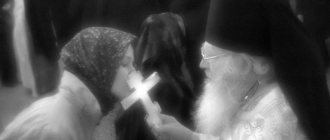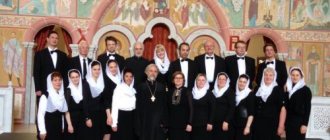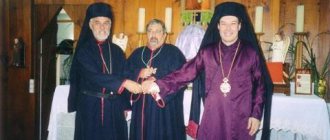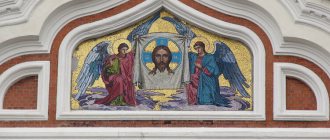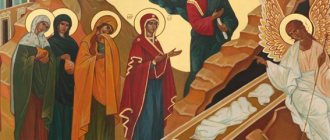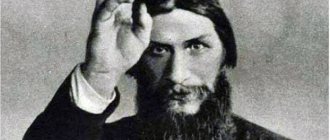Orthodox doctrine and cult
The sources of Orthodox dogma are the Holy Scripture (the books of the Old and New Testaments) and the Holy Tradition (including the entire experience of the church, the teachings of the apostles, the acts and dogmatic decrees of the Ecumenical and local councils, the works of the Fathers of the Church, the lives of saints, etc.).
For the Slavic peoples who adopted Orthodoxy, some of the Books of the Old and New Testaments at the end of the 9th century. were translated into national languages. A complete translation of all books of the Bible into Church Slavonic was carried out at the end of the 15th century. (the so-called Gennady Bible, named after Archbishop Gennady of Novgorod, who led the work on translating the Bible).
The Orthodox Churches are distinguished from the Western Churches by their fidelity to the decisions of the first seven Ecumenical Councils (325 - 787), since the time of which the creation of new church dogmas (indisputable truths) ceased. Which, according to the Orthodox Church, indicates adherence to the original, true Christianity.
A brief summary of Orthodox dogmas is contained in the 12 points (members) of the Nicene-Constantinople (or Nicene-Constantinople) Creed (V.I. Zakharov. Old Testament Trinity. Mstera. 1904). First of all, this is the teaching about the persons of the Holy Trinity - God the Father, God the Son - Jesus Christ and the Holy Spirit (New Testament Trinity. 17th century). Other dogmas are faith in God the Father as the Creator of the world (Six Days, 17th century); in Jesus Christ, as the only begotten Son of God, who became incarnate and became a man, being born of the Virgin Mary; faith in Christ's atonement for the original sin of people through the agony of the cross (Paradise. 19th century); belief in his resurrection from the dead and ascension on the third day; belief in the second coming of Jesus Christ, in the divine judgment of the living and the dead (The Last Judgment. Beginning of the 19th century) and the establishment of the Kingdom of God (The Temporality of Life. Beginning of the 19th century). The Nicene-Constantinopolitan Creed also proclaims faith in the Holy Spirit emanating from the Father (the third hypostasis of the Holy Trinity); to the Holy Collegiate Apostolic Church; into baptism as cleansing from original sin and spiritual rebirth of a person (Pure Soul. Beginning of the 19th century).
The basis of Orthodox liturgical practice and cult are church and private services, during which sacred rites and sacraments are performed.
Each church service is dedicated to some festive event associated with Christ (the so-called Lord's feasts), the Mother of God (Theotokos feasts), one or more saints or a memorable date. The most important holidays are the twelve and great ones. But each church can have its own holidays - local ones. An important role in the religious cult of Orthodox Christians is given to the veneration of saints, their images (icons), relics, relics, and pilgrimages to holy places.
A specific phenomenon of Orthodox religious life is the cult of holy fools (blessed), who enjoyed special respect among the people.
Unlike Catholicism, which has a single center of government (the Vatican), the Orthodox Church consists of separate local (autocephalous, from Greek - “self-governing”) Churches, which include bishoprics (dioceses). A diocese consists of parishes. This division is determined primarily by territorial and administrative boundaries.
Autocephalous Churches are headed by primates, since in the theological sense the only head of the Universal Church is Christ. Currently, there are 15 autocephalous Churches: Constantinople (the Patriarch of Constantinople bears the title of “ecumenical”, but in relation to local churches, he is “first among equals”), Alexandria, Antioch, Jerusalem, Russian, Georgian, Serbian, Romanian, Bulgarian, Cypriot, Greek, Albanian, Polish, Orthodox Church of the Czech Lands and Slovakia, American. In addition, there are four autonomous Orthodox Churches - Sinai, Finland, Crete, and Japan.
Common to all Churches are doctrine and cult, while maintaining canonical (normative and legal) independence.
Fundamentals of Orthodoxy: what they won’t teach you at school
Does the ruler want to hang you on lanterns? Be patient. Are taxes stifling you? Rejoice! Do people cut their tongues for idle chatter? Thank the authorities for admonishing you.
Therefore, since the times of Byzantium, the Orthodox Church has considered its main function to be “filling the people with meekness and entrusting them to the hand of a shepherd.” Some patriarchs, who had a different view of these duties, quickly ended their days in the underground dungeons of Constantinople and could not finally admire their own beautifully released intestines only because the executioners had previously cut out their eyes.
There were certain advantages in this state of affairs: no matter what bloody palace coups, no matter what conquests and revolutions shook the Orthodox country, the invaders and tyrants soon began to understand that the Orthodox Church is the most reliable ideological assistant, which it is simply a sin not to use. Since any power comes from God, then both Mamai and Stalin are pleasing to God. The Russian Orthodox Church managed to prove useful even to the Bolshevik atheists, who, after the first twenty years of persecution against it, eventually lived with the church in perfect harmony. The communists finally restored the institution of patriarchy, which had once been destroyed by Peter I, and from now on there was no need to worry that breakthroughs would occur on the spiritual ideological front: the red priests bravely fought with renegade emigrants from the Russian Church Abroad, and with priests who did not recognize Soviet power and united in the Catacomb Church. The Moscow Patriarchate caught the latter from the underground with the energy of a bloodhound and handed them over to the internal affairs and state security agencies. And the sentiments of lay believers were the subject of regular denunciations by Soviet priests, many of whom considered the secret of confession not such a serious problem compared to the NKVD and the KGB. By the way, one of the last church anathemas was pronounced in 1997 to human rights activist priest Gleb Yakunin. Officially, he was accused of falling away from the church, self-will, and getting involved in politics, but it would be worth remembering that it was Yakunin who constantly demanded an open, honest investigation into the collaboration of ministers of the Russian Orthodox Church with the CPSU and the expulsion from the ranks of the clergy of priests who had soiled themselves with denunciations and too tender an affair with secular Soviet crowns.
Catholicism at one time took a different path. The popes chose the path of struggle and secular power, were the heads of empires, ruled numerous military orders and considered themselves kings over kings. There were eras when not a single king of Europe could put on his crown, and especially keep it on his head, without the approval of Rome (to be fair, we add that there were also times when popes stayed for long periods in prison with secular rulers). Catholics reserved humility and obedience for God, but in secular European life, energy, civic activity and rebellion were considered completely respectable qualities. All this led to the fact that the supra-secular power of the popes became a kind of eternal opposition to any tyrant who would try to unite too many people under his rule and too actively instill in them his personal views on life. And if sometimes the popes themselves began to overdo it with their “government on earth,” then, thank God, there were enough crowned vassals around who were always ready to help the soaring pontiff return to earth as soon as possible. And sometimes under it.
Orthodoxy and Catholicism (main differences)
Catholicism and Orthodoxy have a number of differences. Catholicism is a branch of Christian teaching that arose, like Orthodoxy, in the 1st century. AD in the western Roman Empire. And Orthodoxy is a movement in Christianity that originated in the Eastern Roman Empire. Here is a comparison table:
Relations with authorities
The Orthodox Church, for two millennia, was either in collaboration with the secular authorities, sometimes in its subordination, sometimes in exile.
Empowering the Pope with both secular and religious power.
The Mother of God is considered the bearer of original sin because her nature is human.
Dogma of the purity of the Virgin Mary (there is no original sin).
The Holy Spirit comes from the Father through the Son
The Holy Spirit comes from both the Son and the Father
Attitude towards the sinful soul after death
The soul undergoes “ordeals.” Earthly life determines eternal life.
The existence of the Last Judgment and purgatory, where the purification of the soul occurs.
Holy Scripture and Holy Tradition
Holy Scripture - part of Holy Tradition
Triple immersion (or dousing) in water with communion and anointing.
Sprinkling and dousing. All sacraments after 7 years.
6-8-pointed cross with the image of the victorious God, the legs are nailed with two nails.
4-pointed cross with God the Martyr, legs nailed with one nail.
Every person is unique.
Attitude to rituals and sacraments
The Lord does it through the clergy.
It is performed by a clergyman endowed with divine power.
Nowadays, the question of reconciliation between churches very often arises. But due to significant and minor differences (for example, Catholics and Orthodox Christians cannot agree on the use of yeast or unleavened bread in the sacraments), reconciliation is constantly postponed. There can be no talk of a reunion in the near future.
List of Orthodox churches
| Autocephalous and autonomous Orthodox churches |
| Autocephalous churches |
| Four ancient Orthodox churches: Constantinople | Alexandria | Antioch | Jerusalem Rus' | Georgia | Serbia | Romania | Bulgaria | Cyprus | Greece | Poland | Albania | Czech Republic and Slovakia | USA and Canada* |
| Autonomous churches |
| Sinai | Finland | Estonia* | Japan* | China* | Ukraine* | Macedonia* |
| * — the status of the church is not recognized by any independent Orthodox churches. |
Canonical churches
are divided into two types: autocephalous and autonomous churches. Such churches have their own self-government, but the difference is that the leaders of autonomous churches are approved by the governing body of the mother church.
Such churches exist in full canonical agreement with other churches in the absence of an explicit written agreement as to which churches should be recognized as autonomous and which as autocephalous. However, there are churches whose canonical status was not recognized by all independent churches; in particular, most of the affiliated churches of the Russian Orthodox Church were not recognized by some ancient churches. All churches have a so-called commemoration list, in which the heads of the churches recognized by it are included.
Orthodoxy and modernity
Our times have given the church freedom and support it. Over the past 20 years, the number of believers, as well as those who consider themselves to be Orthodox, has increased. At the same time, the moral spirituality that this religion implies, on the contrary, has fallen. A huge number of people perform rituals and attend church mechanically, that is, without faith.
The number of churches and parochial schools attended by believers has increased. An increase in external factors only partially affects the internal state of a person.
The Metropolitan and other clergy hope that, after all, those who consciously accepted Orthodox Christianity will be able to achieve spiritual success.
Source: https://fb.ru/article/213037/pravoslavie—eto-napravlenie-v-christianstve-religiya
Orthodoxy and Christianity
Many people make the mistake of considering all Christians to be Orthodox. Christianity and Orthodoxy are not the same thing. How to distinguish between these two concepts? What is their essence? Now let's try to figure it out.
Christianity is a world religion that originated in the 1st century. BC e. waiting for the coming of the Savior. Its formation was influenced by the philosophical teachings of that time, Judaism (polytheism was replaced by one God) and endless military-political skirmishes.
Orthodoxy is just one of the branches of Christianity that originated in the 1st millennium AD. in the eastern Roman Empire and received its official status after the schism of the common Christian church in 1054.
The attitude of Orthodoxy to other religions
Orthodoxy is a direction that, having stood out from general Christianity as an independent religion, does not recognize other teachings, considering them false (heretical). There can only be one truly true religion.
Orthodoxy is a trend in religion that is not losing popularity, but on the contrary, gaining popularity. And yet, in the modern world it calmly coexists in the vicinity of other religions: Islam, Catholicism, Protestantism, Buddhism, Shintoism and others.
History of Christianity and Orthodoxy
The history of Orthodoxy (orthodoxy) began already in the 1st century AD. This was the so-called apostolic creed. After the crucifixion of Jesus Christ, the apostles faithful to him began to preach his teachings to the masses, attracting new believers to their ranks.
In the 2nd-3rd centuries, orthodoxy was engaged in active confrontation with Gnosticism and Arianism. The first rejected the writings of the Old Testament and interpreted the New Testament in their own way. The second, led by the presbyter Arius, did not recognize the consubstantiality of the Son of God (Jesus), considering him a mediator between God and people.
Seven Ecumenical Councils, convened with the support of the Byzantine emperors from 325 to 879, helped to resolve the contradictions between the rapidly developing heretical teachings and Christianity. The axioms established by the Councils regarding the nature of Christ and the Mother of God, as well as the approval of the Creed, helped the new movement to take shape into the most powerful Christian religion.
Not only heretical concepts contributed to the development of Orthodoxy. The split of the Roman Empire into Western and Eastern influenced the formation of new directions in Christianity. The different political and social views of the two empires created a crack in the united all-Christian church. Gradually it began to split into Roman Catholic and Eastern Catholic (later Orthodox). The final split between Orthodoxy and Catholicism occurred in 1054, when the Patriarch of Constantinople and the Pope mutually excommunicated each other (anathema). The division of the common Christian church ended in 1204, along with the fall of Constantinople.
The Russian land adopted Christianity in 988. Officially, there was no division into the Roman and Greek Orthodox churches, but due to the political and economic interests of Prince Vladimir, the Byzantine direction - Orthodoxy - was widespread in the territory of Rus'.
What are the main sacraments?
The first is the sacrament of Baptism, in which we are united with Christ. Because immersion in water is a symbol of death, just as the Savior died and was buried. When a person is raised from the water, it is a symbol of resurrection. And the threefold immersion is performed in the name of the Holy Trinity.
The second is the sacrament of confirmation. In it, a person is given the gift of the holy spirit. It takes place after baptism. And the goal of a person’s life is to develop this gift in oneself.
Third - Communion or Eucharist. Through it, the connection formed between a person and Christ during Baptism is maintained throughout life.
Fourth - confession. It helps a person get rid of sins for further work on himself.
Fifth - wedding. It makes husband and wife one.
Source: https://www.kp.ru/putevoditel/mirovye-religii/pravoslavie/
Content
Autocephalous churches
- Ecumenical Patriarchate of Constantinople
- Patriarchate of Alexandria
- Patriarchate of Antioch
- Jerusalem Patriarchate
- Moscow Patriarchate
- Serbian Patriarchate
- Romanian Patriarchate
- Bulgarian Patriarchate
- Georgian Patriarchate
- Cypriot Orthodox Church
- Greek Orthodox Church
- Polish Orthodox Church
- Albanian Orthodox Church
- Czechoslovakian Orthodox Church
- Orthodox Church of America (autocephaly was recognized only by the Russian Orthodox Church, BOC, GOC, POC, ChOC)
Autonomous churches
- Sinai Orthodox Church IP
- Finnish Orthodox Church KP
- Estonian Orthodox Church KP (autonomy was recognized only by the Estonian Orthodox Church)
- Japanese Orthodox Church MP (autonomy was recognized only by the Russian Orthodox Church)
- Chinese Orthodox Church MP (autonomy recognized only by the Russian Orthodox Church)
- Ukrainian Orthodox Church MP (autonomy recognized only by the Russian Orthodox Church)
- Ohrid Archdiocese of the SP (only the SOC recognized autonomy)
Previously independent churches
These churches were previously either autocephalous or autonomous, but have now disappeared or become non-Orthodox.
Unrecognized independent churches
The following churches are not recognized by the mainline churches as independent or canonical.
It should be noted that in the diptychs of the Russian Orthodox Church and other daughter churches, the ranking of the four churches following the Moscow Patriarchate is different. The Moscow patriarch is followed by the Georgian, then the Serbian, the Romanian and, finally, the Bulgarian.
Source: https://ru.orthodoxwiki.org/%D0%A1%D0%BF%D0%B8%D1%81%D0%BE%D0%BA_%D0%BF%D1%80%D0%B0%D0 %B2%D0%BE%D1%81%D0%BB%D0%B0%D0%B2%D0%BD%D1%8B%D1%85_%D1%86%D0%B5%D1%80%D0%BA %D0%B2%D0%B5%D0%B9
